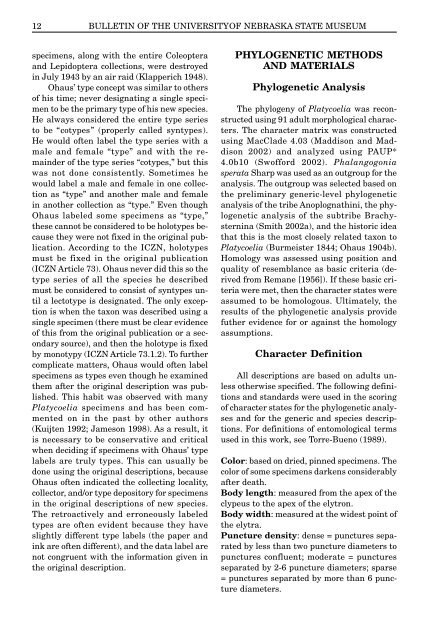Download full text (PDF 4.5 MB) - University of Nebraska State ...
Download full text (PDF 4.5 MB) - University of Nebraska State ...
Download full text (PDF 4.5 MB) - University of Nebraska State ...
You also want an ePaper? Increase the reach of your titles
YUMPU automatically turns print PDFs into web optimized ePapers that Google loves.
12 BULLETIN OF THE UNIVERSITYOF NEBRASKA STATE MUSEUM<br />
specimens, along with the entire Coleoptera<br />
and Lepidoptera collections, were destroyed<br />
in July 1943 by an air raid (Klapperich 1948).<br />
Ohaus’ type concept was similar to others<br />
<strong>of</strong> his time; never designating a single specimen<br />
to be the primary type <strong>of</strong> his new species.<br />
He always considered the entire type series<br />
to be “cotypes” (properly called syntypes).<br />
He would <strong>of</strong>ten label the type series with a<br />
male and female “type” and with the remainder<br />
<strong>of</strong> the type series “cotypes,” but this<br />
was not done consistently. Sometimes he<br />
would label a male and female in one collection<br />
as “type” and another male and female<br />
in another collection as “type.” Even though<br />
Ohaus labeled some specimens as “type,”<br />
these cannot be considered to be holotypes because<br />
they were not fixed in the original publication.<br />
According to the ICZN, holotypes<br />
must be fixed in the original publication<br />
(ICZN Article 73). Ohaus never did this so the<br />
type series <strong>of</strong> all the species he described<br />
must be considered to consist <strong>of</strong> syntypes until<br />
a lectotype is designated. The only exception<br />
is when the taxon was described using a<br />
single specimen (there must be clear evidence<br />
<strong>of</strong> this from the original publication or a secondary<br />
source), and then the holotype is fixed<br />
by monotypy (ICZN Article 73.1.2). To further<br />
complicate matters, Ohaus would <strong>of</strong>ten label<br />
specimens as types even though he examined<br />
them after the original description was published.<br />
This habit was observed with many<br />
Platycoelia specimens and has been commented<br />
on in the past by other authors<br />
(Kuijten 1992; Jameson 1998). As a result, it<br />
is necessary to be conservative and critical<br />
when deciding if specimens with Ohaus’ type<br />
labels are truly types. This can usually be<br />
done using the original descriptions, because<br />
Ohaus <strong>of</strong>ten indicated the collecting locality,<br />
collector, and/or type depository for specimens<br />
in the original descriptions <strong>of</strong> new species.<br />
The retroactively and erroneously labeled<br />
types are <strong>of</strong>ten evident because they have<br />
slightly different type labels (the paper and<br />
ink are <strong>of</strong>ten different), and the data label are<br />
not congruent with the information given in<br />
the original description.<br />
PHYLOGENETIC METHODS<br />
AND MATERIALS<br />
Phylogenetic Analysis<br />
The phylogeny <strong>of</strong> Platycoelia was reconstructed<br />
using 91 adult morphological characters.<br />
The character matrix was constructed<br />
using MacClade 4.03 (Maddison and Maddison<br />
2002) and analyzed using PAUP*<br />
4.0b10 (Sw<strong>of</strong>ford 2002). Phalangogonia<br />
sperata Sharp was used as an outgroup for the<br />
analysis. The outgroup was selected based on<br />
the preliminary generic-level phylogenetic<br />
analysis <strong>of</strong> the tribe Anoplognathini, the phylogenetic<br />
analysis <strong>of</strong> the subtribe Brachysternina<br />
(Smith 2002a), and the historic idea<br />
that this is the most closely related taxon to<br />
Platycoelia (Burmeister 1844; Ohaus 1904b).<br />
Homology was assessed using position and<br />
quality <strong>of</strong> resemblance as basic criteria (derived<br />
from Remane [1956]). If these basic criteria<br />
were met, then the character states were<br />
assumed to be homologous. Ultimately, the<br />
results <strong>of</strong> the phylogenetic analysis provide<br />
futher evidence for or against the homology<br />
assumptions.<br />
Character Definition<br />
All descriptions are based on adults unless<br />
otherwise specified. The following definitions<br />
and standards were used in the scoring<br />
<strong>of</strong> character states for the phylogenetic analyses<br />
and for the generic and species descriptions.<br />
For definitions <strong>of</strong> entomological terms<br />
used in this work, see Torre-Bueno (1989).<br />
Color: based on dried, pinned specimens. The<br />
color <strong>of</strong> some specimens darkens considerably<br />
after death.<br />
Body length: measured from the apex <strong>of</strong> the<br />
clypeus to the apex <strong>of</strong> the elytron.<br />
Body width: measured at the widest point <strong>of</strong><br />
the elytra.<br />
Puncture density: dense = punctures separated<br />
by less than two puncture diameters to<br />
punctures confluent; moderate = punctures<br />
separated by 2-6 puncture diameters; sparse<br />
= punctures separated by more than 6 puncture<br />
diameters.
















